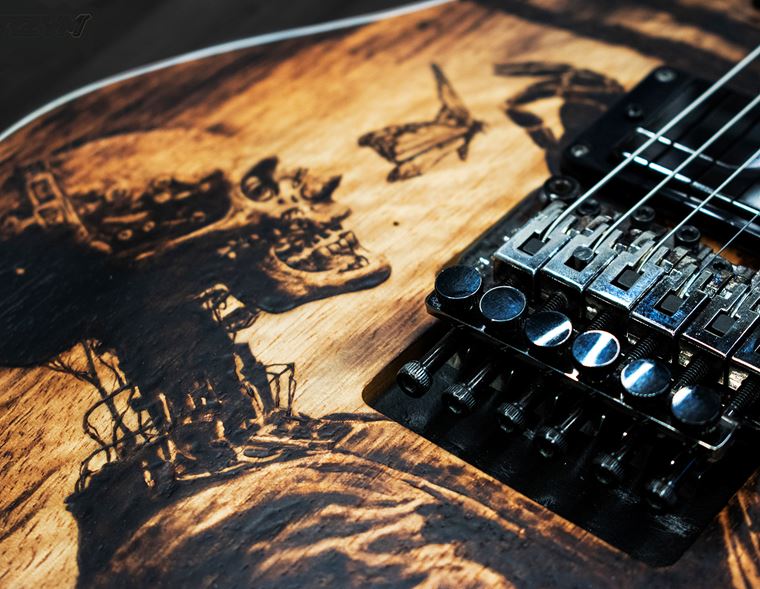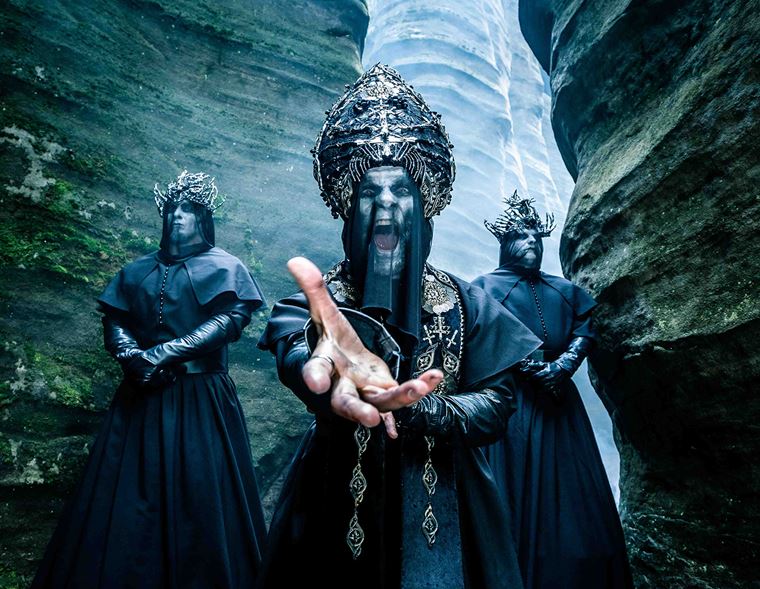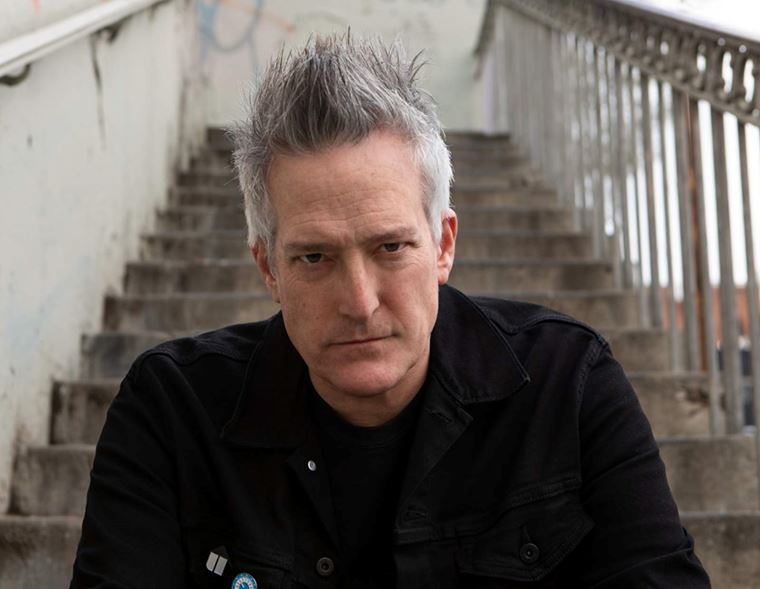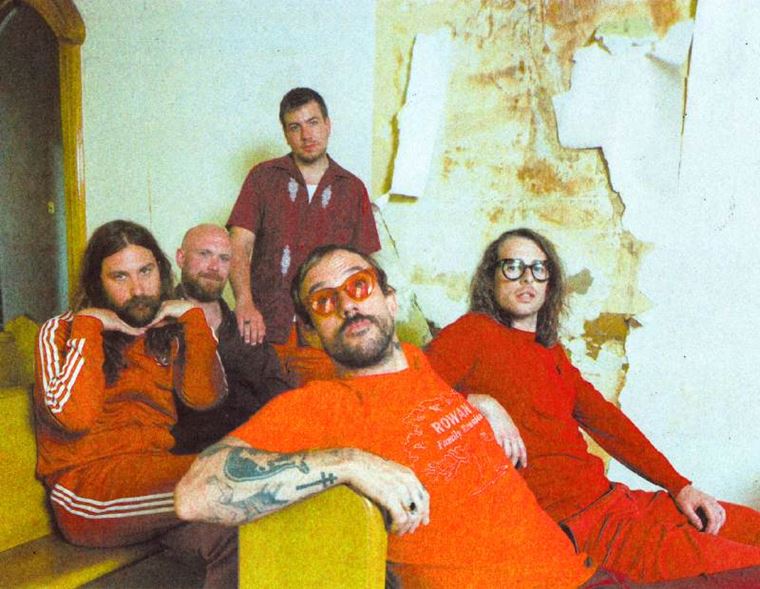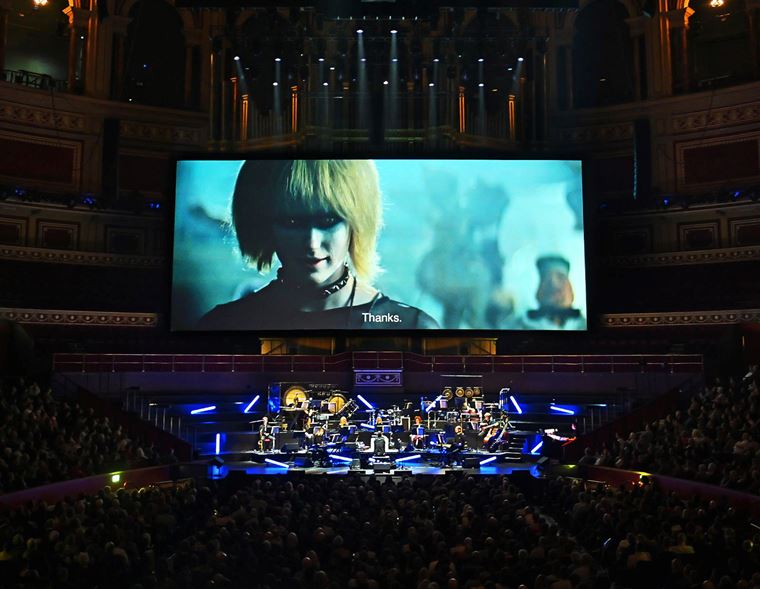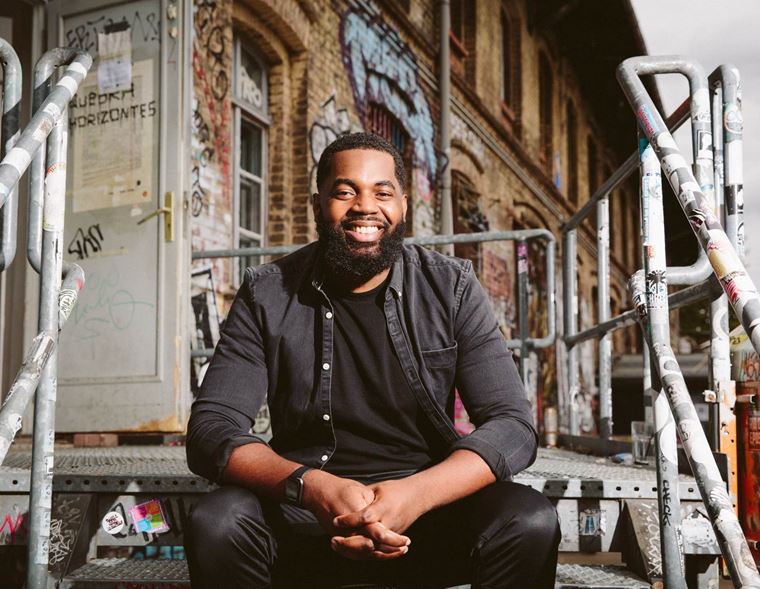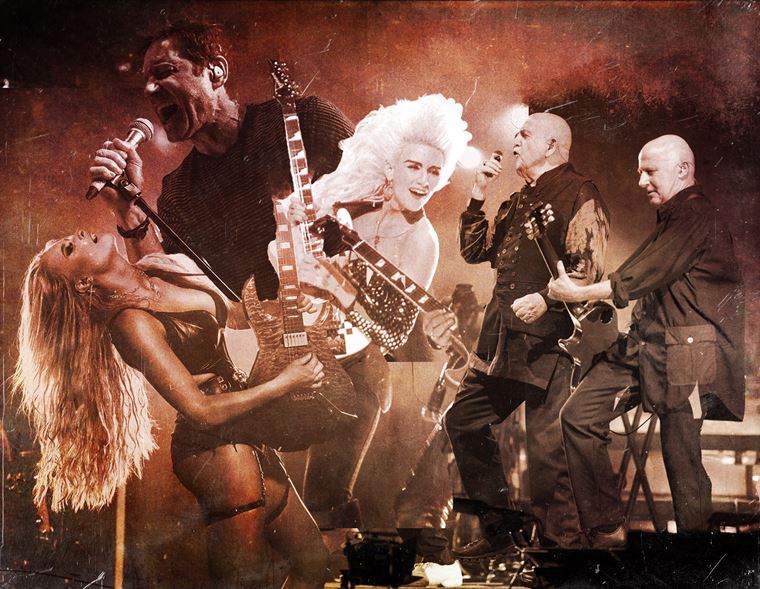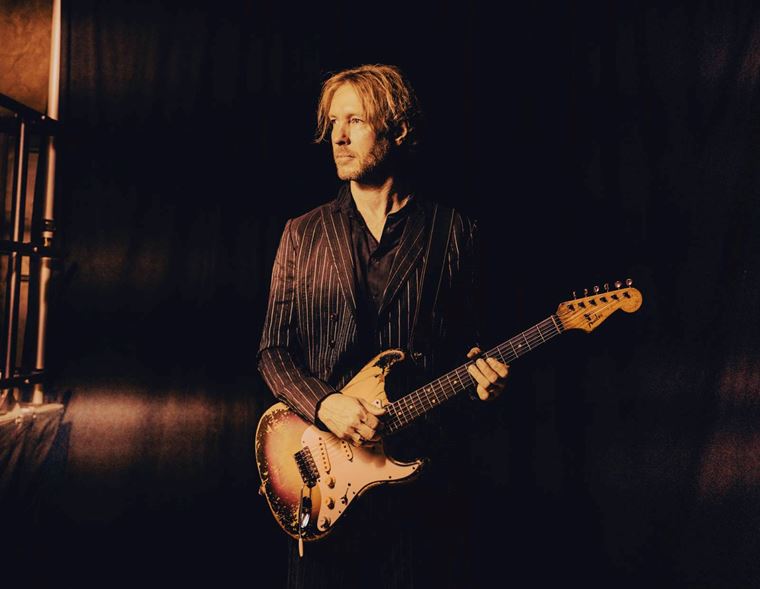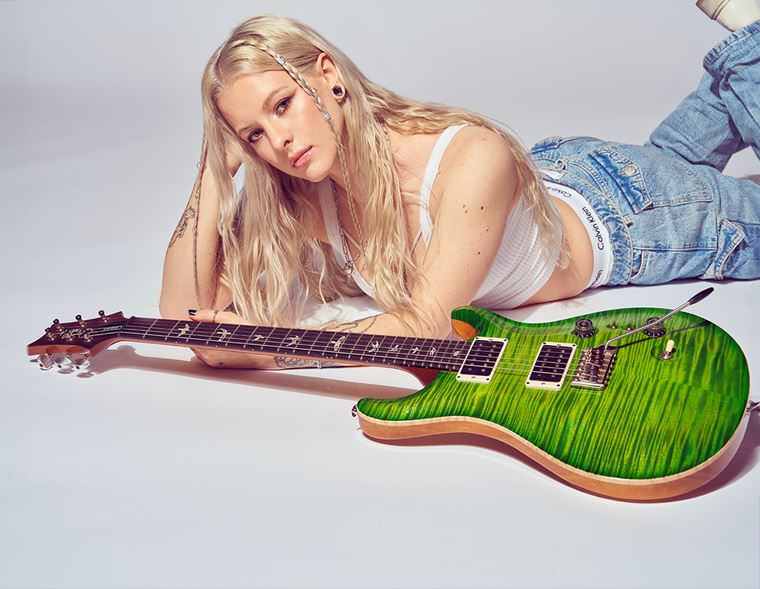The guitarguitar Interview: David Bowie guitarist Gerry Leonard
David Bowie was the greatest artist of the 20th Century.
You’re free to disagree, of course, but you’d be wrong. In terms of influence on everything can came after, in terms of the success his music on a global scale, in terms of his dominance of not only the music world but those of fine art, acting and fashion, the man born David Jones in Brixton in 1947 has zero peers.
Whether you saw him first as Ziggy Stardust, Jareth the Goblin King (as I did) or Nikola Tesla, David Bowie has cast a titanic shadow over culture, enriching lives in all sorts of cultures. It’s very easy to call someone a legend, but most pale in comparison to the Thin White Duke himself.
It has been 4 years since the Starman lifted off and left us behind, leaving a hole in the stratosphere that perhaps no one will ever fill. Love for him remains undiminished, though. As a result, these past few years have seen a special band, put together by various ‘Bowie alumni’ – members from his live and studio bands over the span of his career – tour the world playing his songs to thousands of eager fans every night.
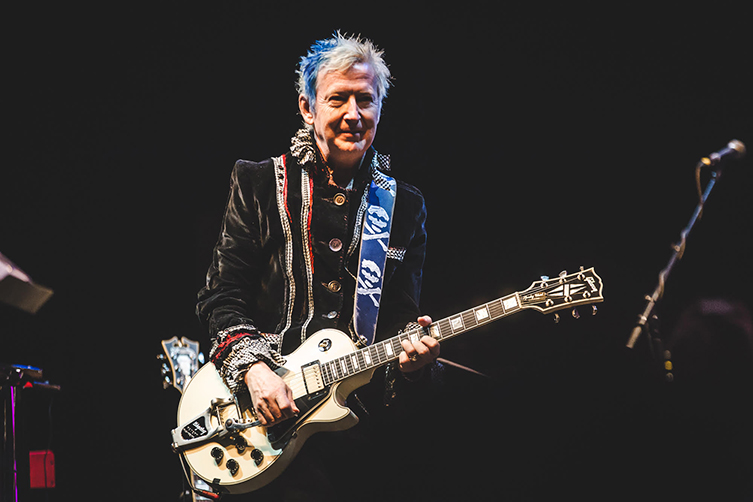
A key member of this Bowie Celebration is Gerry Leonard, aka Spooky Ghost. Leonard played on three of David’s records (Heathen, Reality and The Next Day) as well as acting as Bowie’s musical director on his last worldwide tour, 2003-4’s A Reality Tour. As a player, Gerry is really interesting, as he makes full use of the possibilities of technology to extend the reach of what guitars are ‘supposed’ to do. As a player who grew up on not only 90s Bowie but also Radiohead and Nine Inch Nails, his attitude to sonics make a lot of sense to me. As often happens in this job, it dawned on me, after seeing an ad for the tour, that he might be up for having a chat! It also dawned on me that I might be able to swipe a few tips and tricks to use in my own playing!
Like many of the other Bowie Alumni, Leonard’s relationship with David allowed him a long-term first-person insight into the attitude and working methods of the great man (Gerry has played well over 100 gigs with David). This is a fact that has only grown more precious in hindsight. Indeed, this was something that, I, as a huge Bowie fan, desperately wanted to hear more about...
So, hearing that the Bowie Celebration tour was coming back to town again, I reached out to Gerry, hoping that he’d be interested in talking to me after all. Happily, he got back and gave me the prospective thumbs up! I prepared my questions and looked forward to the day.
A few weeks later, I found myself at my favourite spot behind the O2 Academy, patiently awaiting the batphone-call from the interior of the venue. Instead, the door opened and Gerry himself popped out to bring me in. Friendly and down to earth, he led me back inside, where we hunted for a quiet place to chat. In the end, we interrupted a security briefing as we marched into the upstairs bar for our interview. We had lots of important things to discuss! Gerry was very pleasant to talk to and shared plenty about his pedal setup as well as generously talking about his time with David. It was a great twenty minutes, and they are transcribed in full for you here...
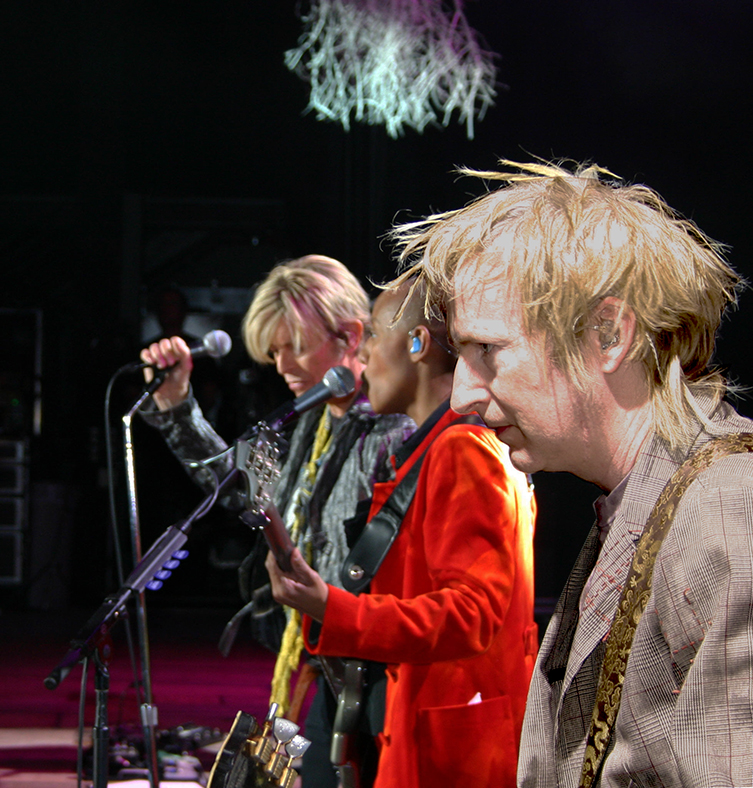
guitarguitar: So, I figured it would make sense to start at the beginning of your story with David. How did you first get the gig?
Gerry Leonard: Yeah, well I had moved to New York City from Dublin. I grew up in Dublin, I had all my bands in Dublin, I’d had a record deal with Island records, and that had all come and gone. I found myself like; either I start another band, or I gotta get out of Dublin, so I went to New York. I had a few trips to New York, and I’d made some friends over there, so I ended moving there and working as a guitar player and a sideman. That’s how I ended up meeting David. I’d worked with an artist called Duncan Sheik, and he had Mark Plati, who is a great engineer/producer, and has worked with David (notably on the Earthling record – Ray). Mark had dome a couple of tracks with Duncan, that’s how I’d met Mark.
GG: I see.
GL: We got along: Mark used me on a few things. And then, Mark was working on the Toy record (Bowie record that is, to date, officially unreleased - Ray), and I was working down the hall in Looking Glass studios, on another little independent record. Mark said: ‘Do you wanna do a track? I want you to do an ambient track’; he knew my stuff. And so I played on the track for David. I said, ‘can I meet him?’ I met him, and I said something stupid (laughs). Apparently, David said to Mark one day: ‘So, can Gerry rock?’ (laughs) Mark’s like, ‘Well, you should be the judge of that! And he’s playing on Thursday’.
GG: Oh cool!
GL: In a little club. I used to do my solo Spooky Ghost thing, as a trio or duo. We’d run cartoons and improvise. So, David came to the show!
GG: Brilliant!
GL: He came to the coffeehouse show. Afterwards he said, ‘Do you wanna join the band?’
GG: Oh, wow! So, was this prior to the Heathen album?
GL: Yes, it was. It was right before the Heathen album. So, we did the Toy record: I played on a few tracks, and then I did some overdubs for him on the Heathen record, and then we did the Low (1977 Bowie masterpiece) and the Heathen records for Meltdown (festival). That was the first thing we did together.
GG: That was your first live gig with David, then?
GL: Yeah, yeah.
GG: Low in its entirety and Heathen in its entirety.
GL: Yes!
GG: That’s a bit of a baptism of fire!
GL: It certainly was! So, that’s how I met him.
GG: That’s some story!
GL: Yeah! Amazing, amazing guy.
GG: So, talking about Heathen, I love the playing right at the beginning of the first track, Sunday. That was my first introduction to your style, which, as far as I can figure, includes lots of loops and lots of layering.
GL: Yeah, and in fairness, I’ve gotta say that David Torn, the amazing guitar player David Torn, he did the loops on the record. That was all his stuff on the record.
GG: Oh, I see!
GL: And then when we went to do it live, I said to David, ‘Look: you know, it would be pretty great if I can just do these loops live rather than running them off a tape or some ...something’, y’know?
GG: Yeah.
GL: So, he was like...you know, David was like that, he was like: do it! So, I was like: ‘Oh, shit’ (laughs). I figured it out and I would do it every night. I wouldn’t store it or anything like that, I would just make it from scratch. But that’s what I had been doing with Spooky Ghost. It was all about making the ambience right there and then in the room because it has a different form. We’ve all played to backing tracks, but backing tracks can sound great in one room and then terrible another night.
GG: Mm-hmm.
GL: You know, and you’re locked into tempos and all that kind of thing. So I got into this thing, where whatever ambiences I was doing, I was creating them live. So, that was really my re-interpretation of David Torn’s loops.
GG: I’m glad you sorted that for me: I watched you performing that part on the Reality Tour live DVD, saw your name on the album credits, and assumed it was your part!
GL: Yeah.
GG: If I’m not mistaken, that’s one that you use a Korg Kaoss Pad on, isn’t it?
GL: Ahhh... (it’s actually more prominent on the track Heathen (The Rays), which Gerry is possibly considering as we speak... - Ray)
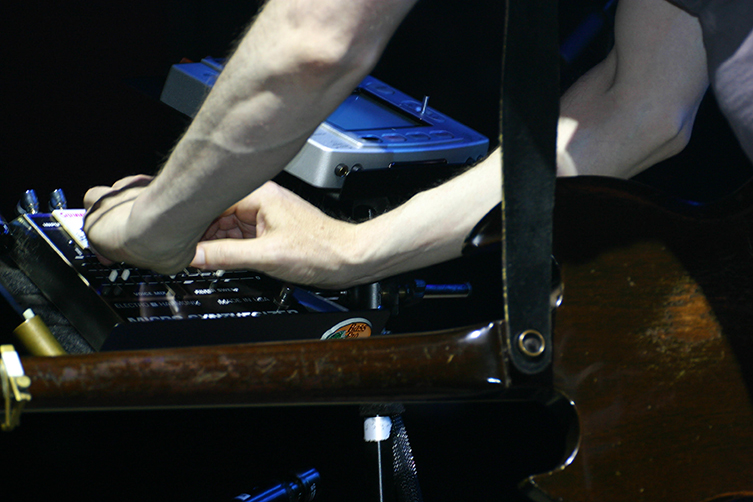
GG: It looks like you were doing a kind of filter thing with it...
GL: Yeah...I know I used it on...yeah, either the Kaoss Pad or the (Electro-Harmonix) Micro Synth at the end to do a filter thing.
GG: It’s sounds so amazing! For the sake of us guitar geeks, whereabouts in your FX chain would the Kaoss Pad go? Last, for the sake of the loops?
GL: Yeah, exactly. The way I had it on that rig, I had the Kaoss Pad and the Micro-Synth mounted on a mic stand, so I could actually physically get to them. So, yeah, I would create the loop, and then towards the end of the loop, I would kick in either the Kaoss Pad or the Micro-Synth, and then I could manipulate the loop. The problem with the Kaoss Pad and those things is, it’s very hard to play and to operate that thing.

GG: You need three hands.
GL: Yeah! (laughs) Or you need to mount it on a guitar like those guys.
GG: Yeah, Matt Bellamy.
GL: But yeah, so generally, I would have a looper. And I was just using a DL4, that Line 6 DL4 for all that stuff.
GG: Really?
GL: Yup.
GG: So, at that point, you were just using one looping device?
GL: Yeah, it’s all done on the Line 6 DL4. All of that stuff.

GG: Nice! So, talking about gear, why don’t we jump ahead to 2020. You’re gonna have to cover a lot of ground tonight.
GL: Yeah.
GG: Am I right in saying you’re gonna be doing all of Diamond Dogs (classic post-Ziggy Bowie album) tonight?
GL: Yes, we’re gonna do Diamond Dogs.
GG: And other tunes as well.
GL: Yeah, we do a bunch of the kinda catalogue.
GG: The hits!
GL: The hits! And a couple of inside tracks as well. You know, we’ll do Aladdin Sane, we’ll do Five Years, or Time, or Panic in Detroit or whatever. So not just the really straightforward hits.
GG: So, what’s your live rig, to cover all of that guitar ground?
GL: Well, this time, the nice thing...even the rig I used with David, it wasn’t huge, but obviously, we had the luxury of travelling with a large crew and all that kinda thing. So, I’ve been trying to make guitar rigs smaller. I have another system that I use, with a switching system, but for this one, I went back. I’d built this pedalboard with the BOSS ES-8 as the kinda centrepiece. I wanted something that could take snapshots of the pedals at different combinations, and also send out some MIDI commands.
GG: Mm-hmm.
GL: And do some pre-set changes. I’m using that and a bit of kinda boutique pedals: different kinds of distortion, I’ve a compressor on there, I’ve a delay, I have a few boxes on there that I don’t use that much but I use a little bit, like the Hexe Revolver, which is like a little mini sampler, you can manipulate it, it’s pretty cool. And that particle...the Red Panda granular, what’s it called? It’s a delay. It’s a little nuts as well! And then I have a Whammy thing, and then I’m using an Eventide H9 for reverbs and some pitch-shift stuff. Well, like, vibratos and tremolos and stuff like that. And some of the ambient stuff. I used to use the H-300 Harmonizer but obviously that’s so huge.
In the David rig, the H-3000 was on one side, on one amp, and I could turn it on and off. I used to call it the most expensive stomp-box I own (laughs) because it was an H-300 in a rack with a mixer and a filter, a Lovetone Meatball.
GG: Oh yeah, those are fantastic! So, what kind of song would you switch the Eventide on for?
GL: Well, I used to use the Eventide for stuff like, well, the Sunday stuff, the Heathen stuff, umm, I would use it on Slip Away, you know, I would use it a lot for the more kinda ambient or, y’know, octave stuff.
GG: Sounds that need a bit of production.
GL: Yeah. That box really has its own sound. It’s very cool: I love the way (Brian) Eno uses it, I love the way a lot of guys use it!
GG: It’s a mystery to me. I think I’ve benefited from the Eventide technology pulling processing forward for us all, but that box remains a mystery to me.
GL: Yeah! (laughs)
GG: Last time I saw you perform, you were using the Supro Two Tone guitar, the David Bowie signature.
GL: Yeah.
GG: What have you got this time?
GL: Well, I have a Gibson SG with me. I was gonna take my Les Paul, but the headstock keeps snapping off (laughs), and I can’t travel with it anymore! I swear to God, four or five times!
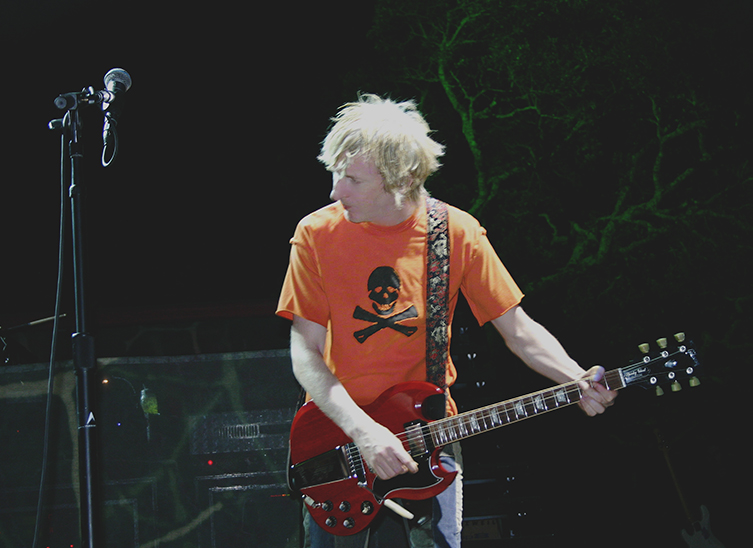
GG: No way!
GL: But I have this SG. My original guitar was a ’69 SG, which is beautiful. This one is a reissue but it’s a little hotter. The pickups are a little hotter and it’s a little better for this Rock stuff. So, the SG, and I do have one of those Supros that I use on a couple of songs. I have this Paul Reed Smith Hollowbody that I use.
GG: Yes, is that the one you used on the ‘acoustic’ version of Loving the Alien on the Reality Tour?
GL: Yes!
GG: That sound could fool anybody, it’s incredible!
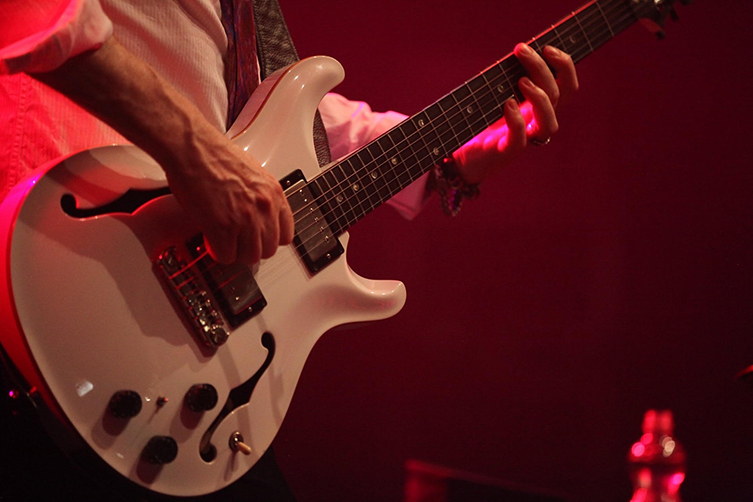
GL: Yeah. So that guitar has a full-blown piezo system in the bridge and then electric, and I use two cables out. One is acoustic and one is electric. I use that guitar a lot with Suzanne Vega, when I do all the duo stuff with her. I use it on my solo stuff. It’s a very powerful instrument because you have acoustic and electric at the same time.
GG: Oh yeah, yeah.
GL: Then, I can loop the acoustic, or I can loop the electric, or I can loop both of them. I’ll do something with it tonight.
GG: Okay, cool!
GL: But I also use it on something like Starman, where I can play the acoustic during the verses and the chorus, and I can kick in a nice electric rhythm sound, because Kevin Armstrong’s gonna do some lead stuff.
GG: Perfect!
GL: Yeah, so it’s a very versatile guitar. And I have Furch 12-string.
GG: Furch?
GL: Yeah, they’re made in the Czech Republic. Beautiful acoustic guitars. They used to make them as ‘Stone Bridge’ in England.

GG: Okay, that rings a bell.
GL: Yeah, but now they’ve come around to the Furch name, and, y’know, they’re really well made, they really sound good.
GG: Sweet. You kinda need a 12-string acoustic for David Bowie stuff.
GL: You do! It’s so much his signature. So, I don’t know if I fully answered that question with the guitar rig. Basically, I wanted to build a kind of Rock pedalboard. The ES-8 was the middle point of it. There’s a Roger Mayer Voodoo, there’s a Tumnus kind of Klon drive, there’s another...it’s called the Vulcan Narvis or something like that, (could be Vulcan Argo Navis, a mean fuzz from Denmark – Ray), it’s like a Big muff, but it’s a modern version of it. It’s a pretty good sounding fuzz.
GG: So the Tumnus is like the Klon Centaur kind of style?
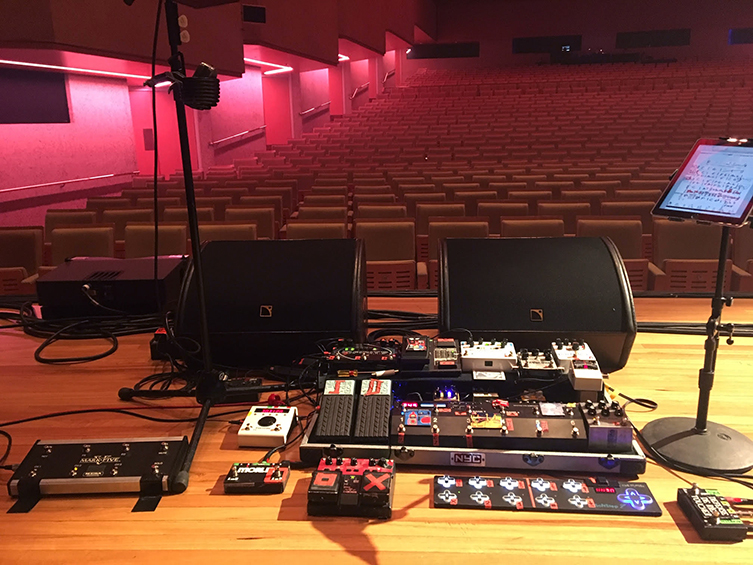
GL: Yeah.
GG: Which is champagne!
GL: Yeah! Well, what’s interesting, and I’ve a couple of pedals that can do it, is that there’s a blend control. You can get into this thing where you’re starting to add a little bit of pedal distortion, but you’re not losing the original signal, and that’s kinda nice.
GG: Like a clean boost, you mean?
GL: Well, the drive actually goes, when you’re counter clockwise, it’s straight guitar, it’s not added to at all. As you bring up the drive, it adds the drive and blends out the original signal too. If you were fully clockwise, it would be just overdrive. So, you can get a blend in between. As a pedal that’s not super high gain, but as a kind of like adding a little bite of bite type of thing, it’s really useful. Really useful!
GG: I had a Voodoo Lab Sparkle Drive, which I think did a similar thing.
GL: The Sparkle Drive! Exactly! The Sparkle Drive does the same thing.
GG: Never off the pedalboard! It’s essential!
GL: Yeah!
GG: So, with your looping, do you do much of it on this tour?
GL: I do, I do a little bit, and on this board I have the Pigtronix Infinity looper. It’s really great, it’s got a lot of detail, but I have the Keith McMillen Softstep controller. Really, to unlock the possibilities of that pedal, you need this controller as well.

GG: Is that for additional MIDI functions?
GL: Yeah, you can do it with a remote, but you do need a dedicated thing to do it.
GG: Yeah. Do you ever think that with the Microsynth, it would be really nice to have extra control? Like, the really cool things happen when you manipulate the pedal after you play the note! You need something else to keep moving the controls!
GL: Yeah. Yeah, I know! I wish they would do that. There’s the HOG, they came out with the HOG (Electro-Harmonix Harmonic Octave Generator), which is almost a similar...it’s like a combination of the POG and the Microsynth. It does have a foot controller and you can assign it to lots of functions.
GG: Quite a lot of pedalboard real estate with that one, it’s huge!
GL: Yeah, it’s a big one.
GG: If you want the HOG, you maybe have to lose some other pedals.
GL: Yeah. Those ones stay at home now.
GG: Fair enough! Haha. So, what about plectrums and strings? For a set like tonight, what are you using?
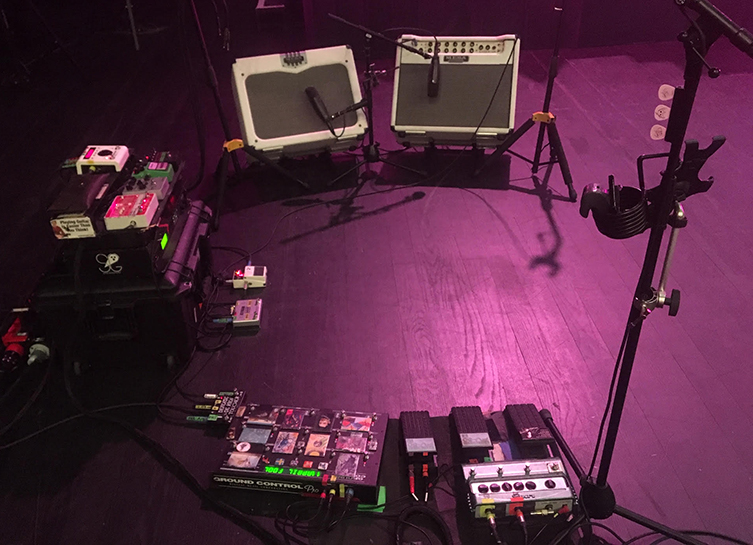
GL: Well, you know, depending on the guitar, it’s 9s or 10s. On this SG, I’m using 9s because it’s just, it makes the bending a little easier for the Rock stuff. But with the Les Paul, I’d have 10s on it for the same thing. That guitar responds better with 10s, this one responds better with 9s. So, generally, I do that. Now, with the acoustics and stuff like the PRS, I use a set of 10s, but there’s a wound 3rd. That makes it feel more like an acoustic guitar. It’s not so great if you need to bend the 3rd string, cos the wound is really stiff.
GG: Yeah, totally.
GL: Yeah. On the 12 string, I think the guys have put 11s or 12s on it, but I would be happy with a set of 10s on there! (laughs)
GG: Oh really? (laughs)
GL: Yeah, cos it kills me!
GG: Yeah, yeah, holding down those F barre chords in Space Oddity! Agony!
GL: Yeah!
GG: What about picks? What’s your preference?
GL: Uh, the .73mm yellow Tortex.
GG: You can’t go wrong with them!
GL: I love them!
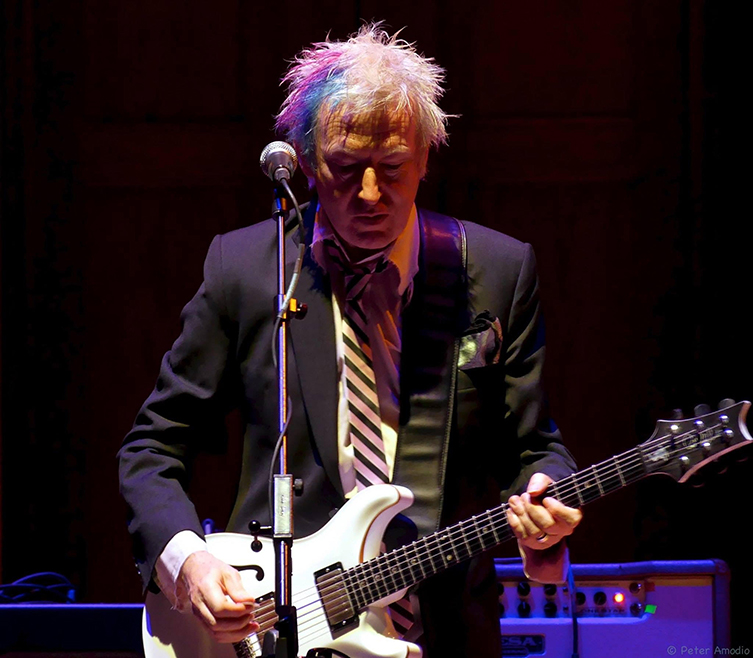
GG: So, how do you guys pick the setlist for each tour? Last time was totally different to this time, and you’re doing all of Diamond Dogs, so that leaves only limited time...
GL: Yeah, and we had a lot more songs, and we had to cut a lot of stuff. For the first show, we had to cut so many songs out. You know, Mike, Mike Garson (extraordinary pianist on many of Bowie’s records from Aladdin Sane to Outside and beyond), who is kind of like our bandleader in this situation, he generally picks the setlist. If we decide to do something like Diamond Dogs, I mean obviously that’s 40 minutes right there. When we go to the States, we’re gonna do Diamond Dogs and the Ziggy (The Rise and Fall of Ziggy Stardust and the Spiders from Mars – Ray) album. But then there’s a bunch of other songs that are competing for our attention. It sometimes depends on the singers we have. What suits them.
GG: Right, of course!
GL: We have the amazing Sass Jordan singing with us and like: Panic in Detroit, Time, Rock ‘n’ Roll Suicide; they’re songs that really suit her, so we do those. And she can really sing high and she can belt so...she’s great.
GG: That’s a good point: the singers determine the songs.
GL: Yeah. And then, you know, there are certain songs that, on a night like this one, we’re celebrating David, we didn’t have Ziggy on the list but we put it back on the list because everyone wants to kinda play their guitar to Ziggy, you know what I mean?
GG: Yeah!
GL: So, we try and make it so that...we’re really doing it for the fans, so we wanna show that there’s some crowd pleasers in there, too.
GG: Yeah, cool! Of course. Now, would you be playing Heroes tonight?
GL: If I told you that, I’d have to kill ya.
GG: Haha! Okay, if you were approaching Heroes...
GL: We’re gonna do it tonight.
GG: Okay, cool! Don’t kill me! Haha! That guitar part that Robert Fripp played is impossible to recreate. It was all about feedback from the monitors in the studio, wasn’t it?
GL: Feedback, yeah. You know, over the years I just do a version with an E-Bow.
GG: Right okay, cool.
GL: And I have some treatments on it, and with the E-Bow, I can swell in and out, I can make it jump an octave or whatever. It works pretty well.
GG: For the octave jumping, is that using the little switch on the E-Bow?
GL: Yeah, I use the switch, and if you come over the pickup... (mimes moving his right hand across imaginary strings)
GG: Ohh!
GL: Like you can really, you can crescendo, and de-crescendo by moving it away from the pickup.
GG: I didn’t realise that!
GL: Yeah! Yeah, a lot of people just go ‘Eeeeeehhhhhh’ (hums a generic E-Bow sound) and just hold it, but if you move it around...I generally try to use the neck pickup. The strings like to be able to vibrate and if you use the treble pickup, the piece of the string between the E-Bow and the pickup is actually really tight. But if you use the neck pickup, you get a lot more range, and then by moving the E-Bow over the pickup and away from the pickup, so back towards the bridge or over the pickup, you can get a real crescendo.
GG: That’s cool: you get some control over the harmonic content.
GL: Yeah. And if it’ll catch the upper harmonic, it’ll drive it a little more. So, you can play around with that.
GG: That’s awesome! There’s something about giving up your entire right hand for the E-Bow that dictates your attitude.
GL: Your guitar becomes monophonic. You can’t do any more than that, so.
GG: It’s a real commitment.
GL: You gotta commit to it! (laughs)
GG: I guess, one last question, if it’s okay? It’s an obvious one, but here it is: David Bowie was a legend. I never met him; you’ve worked with him for years...
GL: Yep.
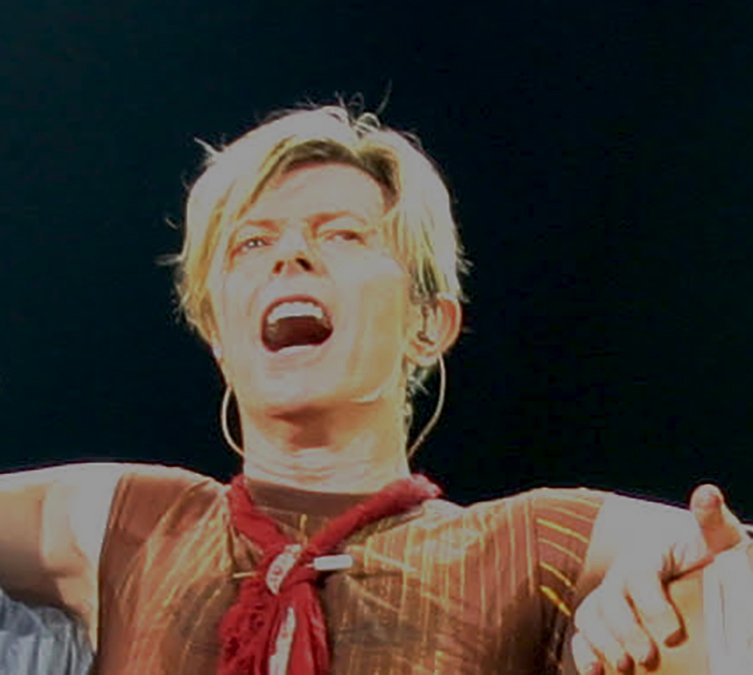
GG: Are there any nice memories or vibes you can share about what it was like working with David?
GL: You know, I have a lot of great memories of working with David, but I gotta say, you know, I mean, he was an amazing person. To work with as a musician and an artist, he was really the real deal, and had a great vision about what he wanted to do. He didn’t micromanage you, he really encouraged you to do your own thing. That’s really great, it’s the best of both worlds because you’re with somebody (to whom) you wanna do your best, but you only get the best out of musicians if you’ll let them be. If you constantly pick at them and tell them what to play, they’ll shut down and you’ll end up with okay stuff, but you won’t get great stuff. I think he knew that, so.
GG: He was after greatness.
GL: Yeah and he wanted you to bring it. He wanted you to do your thing, you know? So, that’s the best combination. But amazing, amazing times on tour. Performing with him was always, you know, he was such a great performer, and he gave so much. I learned a lot about live performance working with him.
GG: Haha, he was a master, right?
GL: Yeah! And he didn’t get stuck on anything. If something went wrong? Fuck it. Doesn’t matter. Just keep going.
GG: Just keep going.
GL: Yup.
GG: That’s the sign of a guy who knows what’s important.
GL: Very evolved.
By this point, the venue’s doors had opened to the public and people downstairs were flooding into the theatre. Gerry and I made our way back downstairs, said goodbye, and he zipped through the audience to the backstage door next to the stage.
The Bowie Alumni played fantastically that night. It’s fair to say that yes, there was one conspicuous absence on stage, meaning that these shows are simultaneously triumphant and elegiac in nature. Nevertheless, with vocalists like Living Colour’s Corey Glover unleashing his astonishing voice at us, there was still plenty of star power on hand. The packed-out audience loved every minute, and you could tell that it meant a lot for Garson, Leonard and co, too.
Relative to our earlier conversation, I realised that Gerry had been holding out on me: toward the end of the night, the ‘little thing’ he mentioned he was going to do with his looper turned out to be a (quasi) acoustic rendering of none other than Loving the Alien, the very song I’d asked about! His take on Fripp’s immortal guitar part on Heroes was emotive and effective, and the whole evening was a great reminder that David Bowie had, and has, far more great songs than can ever fit into a single show.
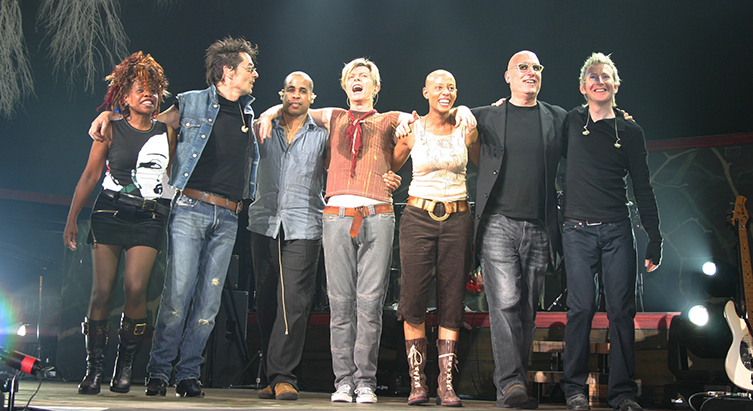
The legend lives on, ably carried into the future by the friends and fellow musicians he has touched the most.
The Bowie Celebration tour is happening now: check the Bowie Celebration website for news and updates. Gerry’s solo music is available from his official Spooky Ghost website.
I’d like to thank Gerry for making time for me, and for sharing his memories of David. All of the pictures in the article are courtesy of Gerry, too.
Thanks for reading guys,
Until next time!



